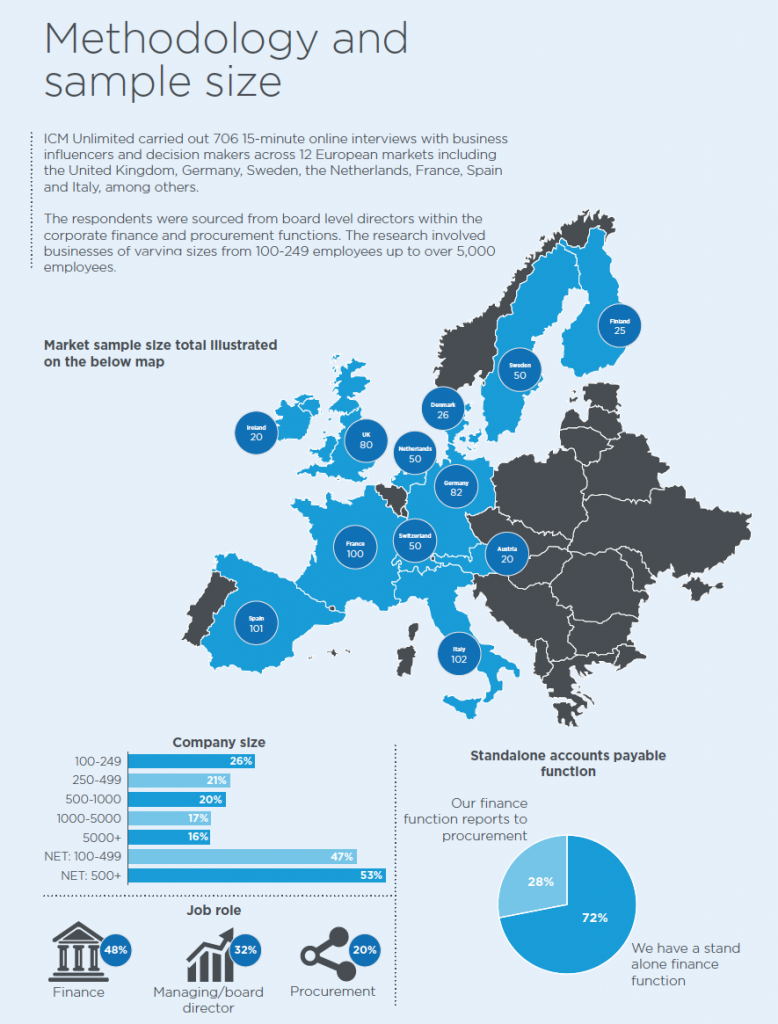26 Feb 2017 P2P trends – the future of purchase to pay
Surprisingly, Europe is distinctly immature when it comes to the implementation of P2P technologies. In a survey across 12 European Markets it was found that most businesses that they have yet to fully control spend using Purchase Orders (PO) and half say they have less than 50% of their spend under control. However, this immaturity is not due to lack of ambition. There is almost universal agreement that the P2P process will be automated in the future, and over half of the European companies have already begun that journey.
DOWNLOAD THE REPORT HERE
According to the survey, streamlining P2P is clearly a top priority, alongside the need to strengthen collaboration between finance, procurement and buyers with suppliers. This determination to improve is shared across both procurement and finance decision makers. Business leaders name process improvements and cost reduction as their top P2P priorities. The key drivers behind these goals are being better able to control spending and cash flow, reducing risks and errors and creating efficiencies by improving productivity.
One of the more startling findings of this research is the lack of P2P analytics tools in use. Despite the weight put behind the importance of P2P, most organisations are pulling information together manually, from many disparate data sources. Considering the plethora of P2P analytics tools available today, this vacuum could be filled in the coming years.
 Organisational change seems to be a major factor in the further maturity of P2P. Whereas the accounts payable function in a business was traditionally managed from within finance, within nearly a third of organisations we spoke to, this team reports in through procurement. This is significant and it reflects the importance of developing an end-to-end view of P2P. However, what is now emerging as best practice is by no means universal. Only a third of organisations believe that their procurement and finance functions are closely aligned, although most agree that better collaboration between finance and procurement is a good thing. Within the next two years, 39% of businesses think the two departments will achieve closer alignment. Technology will play an important role in this transition; and 76% of businesses believe that closer collaboration can be achieved by leveraging end-to-end P2P technology. However, it seems that finance needs procurement more than procurement needs finance. Finance departments are twice as likely (32%) to want to collaborate more with procurement than vice versa. This could be because procurement objectives are nearly always related to commercial savings and management of supply chain risk, whereas finance are more process and control driven – for which they rely on procurement to cooperate.
Organisational change seems to be a major factor in the further maturity of P2P. Whereas the accounts payable function in a business was traditionally managed from within finance, within nearly a third of organisations we spoke to, this team reports in through procurement. This is significant and it reflects the importance of developing an end-to-end view of P2P. However, what is now emerging as best practice is by no means universal. Only a third of organisations believe that their procurement and finance functions are closely aligned, although most agree that better collaboration between finance and procurement is a good thing. Within the next two years, 39% of businesses think the two departments will achieve closer alignment. Technology will play an important role in this transition; and 76% of businesses believe that closer collaboration can be achieved by leveraging end-to-end P2P technology. However, it seems that finance needs procurement more than procurement needs finance. Finance departments are twice as likely (32%) to want to collaborate more with procurement than vice versa. This could be because procurement objectives are nearly always related to commercial savings and management of supply chain risk, whereas finance are more process and control driven – for which they rely on procurement to cooperate.
The technology landscape across Europe is fascinating and there are distinct geographic trends. The growth in the adoption of electronic invoicing remains static, despite the recent hype. Typically, less than a third of organisations have automated e-invoicing. Only in the Nordics and Italy does automated e-invoicing exceed paper invoices and, interestingly, e-invoicing is one of the strongest technologies (second only to document management) when looking at those companies who have already or intend to fully implement these technologies.
The research has shown that European businesses have a very clear view on how they want to work with solution vendors. There is a remarkably strong sentiment towards outsourcing P2P, as there is to working with a single vendor across the entire P2P spectrum, rather than cherry picking point solutions. This is especially true in the Nordics, Italy and Spain.
The market for P2P solutions providers will become less fragmented. The ability to work with a single partner will provide end-to-end P2P solutions and services under several delivery models and be crucial to the successful transformation into a P2P excellence organisation.
The findings contained in this report reflect the views of finance and procurement leaders across Europe, as they consider their goals now and moving into the future. It is a snapshot of the expectations of how the world of Purchase to Pay (P2P) will evolve, where the priorities are, the delivery models that we will see and the organisational changes we can expect.
Pete Loughlin can be found on twitter @peteloughlin


